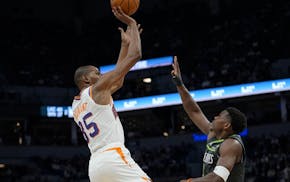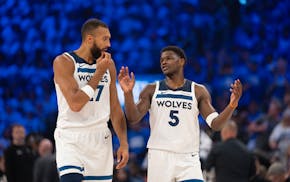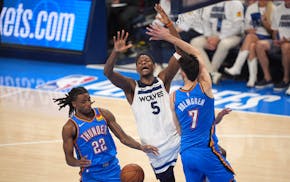Paige Bueckers completed one of the greatest college basketball careers ever Sunday, leading UConn to its first national title since 2016.
Almost six years ago, Bueckers started her career at Connecticut while a less celebrated recruit, Caitlin Clark, was beginning her career at Iowa.
Both became legends.
So why, as a women's basketball aficionado asked me recently, was Clark more of a national phenomenon, more of a crossover superstar, than Bueckers?
First, let's compare their careers.
Both played four seasons in college.
Bueckers won a title and played in four Final Fours for a powerhouse program. Clark did not win a national title but played in two Final Fours for a program that has made only one other Final Four appearance in its history.
Bueckers was the national player of the year once. Clark won it twice. They were co-freshmen of the year.
Bueckers will, like Clark, be the first pick in the WNBA draft.
A comparison of their statistics reveals a few surprises.
Clark was an impeccable shooter and Bueckers the ultimate passer, right?
Clark averaged 8.2 assists per game in college; Bueckers averaged 4.6.
Clark shot 37.7% from the three-point arc and 46.2% overall; Bueckers shot 42.3% from three and 53.1% overall.
Clark was the bigger, stronger player and thus the better defender, correct?
Bueckers averaged 2.1 steals and 0.8 blocks per game; Clark averaged 1.5 and 0.5.
Bueckers averaged 1.7 turnovers per game; Clark averaged 4.6.
Clark averaged more points, rebounds and assists per game; Bueckers played with more highly recruited teammates.
Whichever player you value more, there is little doubt that Clark became more famous in the eyes of casual sports fans.
Why?
I have a few ideas.
1. Clark was more spectacular
Bueckers sought traditional shots and made them with little flair. Her three-pointers almost all came from just behind the arc, and her favorite two-point shot was a pull-up jumper in the lane. She excelled by making the right plays and coming up big in the clutch.
Clark colored outside the lines, taking step-back 28-foot three-pointers, shooting from near the logos on the court, fighting through double teams with elbows high and playing with more visible emotion.
If they worked in Vegas, Bueckers would have been the magician doing card tricks, Clark would have been in Cirque du Soleil, leaping off the high dive headfirst into a puddle.
2. Clark overachieved
As great as Bueckers' career was, her successes were expected. She was the best high school player in the nation as a senior and went to the greatest program in the history of women's college basketball.
Clark played high school ball in Des Moines and went to the local college without much fanfare. Then she elevated that program to unforeseen heights.
3. Clark was controversial
Clark screamed on the court, played with a chip on her shoulder and wound up feuding, at least briefly, with Angel Reese.
Bueckers never wavered from the classy, friendly persona she developed at Hopkins High.
Conflict sells.
4. Clark fit the narrative
Bueckers followed in the footsteps of many great UConn players who elevated the program. UConn women's basketball is the closest thing there is to a professional sport in Connecticut. When you play for UConn, you don't have much reason to worry about the popularity of women's sports.
Clark was different. She attracted rural white sports fans who might have been shocked by the quality of women's basketball when they finally tuned in.
Clark also was the best player in the sport when the sport was fighting to be included under the banner of "March Madness," and when the NCAA was forced to start providing better facilities for women's teams in the tournament.
While she was drawing eyes and ears to her sport, Clark was also drawing eyes and ears to the inequities of her sport.
Bueckers and Clark helped popularize women's basketball. They faced each other just twice in college.
I'm looking forward to their time together in the WNBA, when those meetings will occur with greater frequency.

Souhan: Anxiety and depression in the NFL helped inspire Lindsey Young's children's book
Souhan: For Lynx star Napheesa Collier, 'Phee' is just fine

Souhan: Will the Wolves trade for Kevin Durant? Should they?

Souhan: If Edwards is a franchise player, he needs to act and play like it

